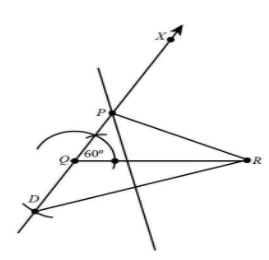
Construct a triangle PQR in which $QR = 6\,{\rm{cm}}$, $\angle {\rm{Q = 60}}^\circ $ and ${\rm{PR}} - {\rm{PQ}} = {\rm{2}}\,{\rm{cm}}$.
Answer
574.2k+ views
Hint: In this problem, to construct the triangle PQR use the method of construction of a triangle with one side, one angle and difference of other two sides.
Complete Step-by-step Solution
Given,
One side of the triangle is $QR = 6\,{\rm{cm}}$.
The angle Q is $\angle {\rm{Q = 60}}^\circ $.
The difference between PQ and PO is ${\rm{PR}} - {\rm{PQ}} = {\rm{2}}\,{\rm{cm}}$.
The following are the steps to construct a triangle PQR.
1. Draw the baseline of triangle as $QR = 6\,{\rm{cm}}$.

2. Now, draw an angle of $60^\circ $ from point Q. To make an angle of $60^\circ $, draw a semicircle from point Q and with the same radius of compass intersect this semicircle from point X.

3. Open the compass and fill the distance ${\rm{PR}} - {\rm{PQ}} = {\rm{2}}\,{\rm{cm}}$ and draw an arc from point Q at opposite side of ray QX.
4. Arc intersect ray QX at point D. join point R and D.
5. Now draw a perpendicular bisector of line RD, and extend the line up to ray QX. Mark point P where perpendicular bisector intersects ray QX.
6. Now join PR.

Hence, $\Delta PQR$ is a required triangle.
Note: In such types of problems, while making bisectors of angles remember that radius of compass should be the same to bisect an angle and use a sharp pencil to draw points and to get accurate results.
Complete Step-by-step Solution
Given,
One side of the triangle is $QR = 6\,{\rm{cm}}$.
The angle Q is $\angle {\rm{Q = 60}}^\circ $.
The difference between PQ and PO is ${\rm{PR}} - {\rm{PQ}} = {\rm{2}}\,{\rm{cm}}$.
The following are the steps to construct a triangle PQR.
1. Draw the baseline of triangle as $QR = 6\,{\rm{cm}}$.

2. Now, draw an angle of $60^\circ $ from point Q. To make an angle of $60^\circ $, draw a semicircle from point Q and with the same radius of compass intersect this semicircle from point X.

3. Open the compass and fill the distance ${\rm{PR}} - {\rm{PQ}} = {\rm{2}}\,{\rm{cm}}$ and draw an arc from point Q at opposite side of ray QX.
4. Arc intersect ray QX at point D. join point R and D.
5. Now draw a perpendicular bisector of line RD, and extend the line up to ray QX. Mark point P where perpendicular bisector intersects ray QX.
6. Now join PR.

Hence, $\Delta PQR$ is a required triangle.
Note: In such types of problems, while making bisectors of angles remember that radius of compass should be the same to bisect an angle and use a sharp pencil to draw points and to get accurate results.
Recently Updated Pages
Master Class 12 Business Studies: Engaging Questions & Answers for Success

Master Class 12 Economics: Engaging Questions & Answers for Success

Master Class 12 English: Engaging Questions & Answers for Success

Master Class 12 Maths: Engaging Questions & Answers for Success

Master Class 12 Social Science: Engaging Questions & Answers for Success

Master Class 12 Chemistry: Engaging Questions & Answers for Success

Trending doubts
What is meant by exothermic and endothermic reactions class 11 chemistry CBSE

Which animal has three hearts class 11 biology CBSE

10 examples of friction in our daily life

One Metric ton is equal to kg A 10000 B 1000 C 100 class 11 physics CBSE

1 Quintal is equal to a 110 kg b 10 kg c 100kg d 1000 class 11 physics CBSE

Difference Between Prokaryotic Cells and Eukaryotic Cells




